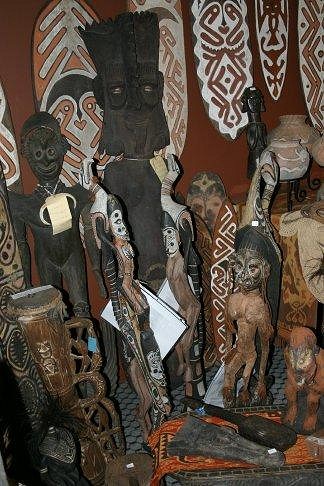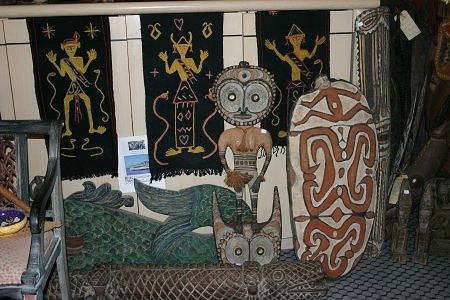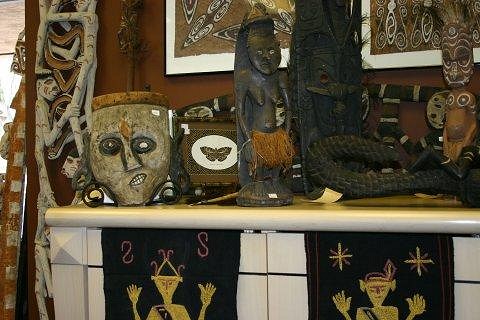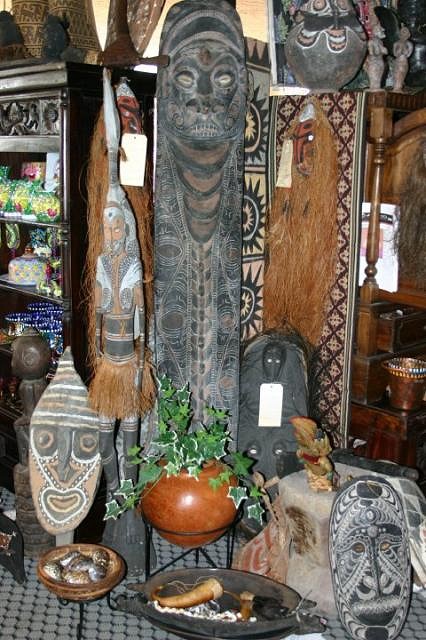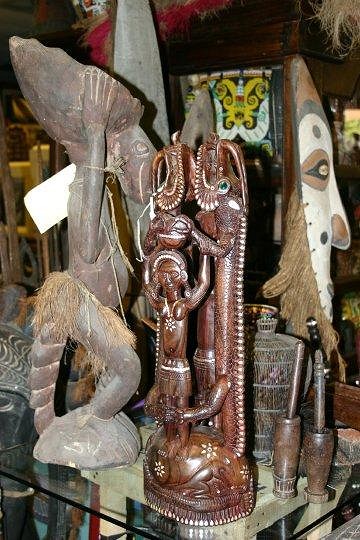Tiki Central / Collecting Tiki / Oceania, Etc: vendor of South Seas Art
Post #157769 by I dream of tiki on Tue, May 10, 2005 6:14 PM
|
IDOT

I dream of tiki
Posted
posted
on
Tue, May 10, 2005 6:14 PM
Dominique asked me to post some photos of what she has in Oceania,etc. Very exciting.
The village of Palembei is graced with two haus tambarans which are the men's houses. Unquestionably the cultural life that persists so strongly in this village has much to do with their presence as they preside over the village with the ghost of the previous spirit house close by. The crumbling house’s posts of the previous building remain until they become one with the earth again further reinforcing the continuing cycle.There, master carvers, whose work appear in Art Exhibitions around the world, created beautiful slim polychrome statues inspired by their spiritual beliefs and traditional tales. While firmly based in tradition, these contemporary works abound with both innovation and individual expression (not withstanding the relatively crude implements including stone adzes and drills and the shark skin rasps and polishes which are used to produce works of delicate grace.) On the back wall are a few gope boards: In the Papuan Gulf province, located on the southern coast of Papua New Guinea, two dimensional works predominate superseding three dimensional sculpture in importance. Painting and relief carving is comprised of mostly symmetrical, curvilinear and chevron forms; red, black, and white compose the color scheme. Papuan Gulf art also shares stylistic elements with the central Sepik area and the northeast, suggesting a possible cultural link between these areas. Gope boards are elliptical in shape and incised with brightly colored abstract patterns. Warriors were entitled to have a gope board for each act of bravery and a board from the vanquished enemy's canoe held particular significance, transferring some of its previous owner's strength to the victor. Almost every ceremonial house contains numbers of oblong oval boards, with one side decorated with painted reliefs. Each of these gope boards is closely linked to a person or a special event; they are displayed with skulls of victims of head hunting rituals, either to protect clansmen from vindictive spirits of the enemy trophy heads or to enslave the spirits of the victims to the spirits of the gope."
"2)A food hook from Palembei, PNG with a big round face: Food hooks are used functionally to preserve food and they hang from rafters in the hut: Food goods are hung from the hook in bilums (woven bags) or baskets to keep it safe from rats and mice, and children too!. Suspending food from the food hook discourages vermin, and the spirit thought to inhabit the hook is believed to retard spoilage. Skull hooks or racks have a similar use and display hanging skulls of ancestors or enemies." "3) Behind the hook is a large handcarved green fish that was once hanging from the front of a decorated boat in Madura, East of Java. and on the right of the hook is an asmat plate reminiscent in design and color of the gope boards from a quite opposite area of this large island."
On the wall in back are seen some examples of framed tapa cloth from Irian jaya used in a region that has no cotton as a form of cloth and wear, made out of pounded bark and not woven then handpainted with motifs and natural pigments. The center statue represents a bride wearing the woven-with-nassa-shells' bride's veil shown on another of these sets of photos below."
Next to the statue on the right are 2 very old little lime containers and spatulas from the islands as well: Betel chewing is a central part of life in East New Guinea. Children even start chewing when they are a few years of age. Betel chewing is a mild stimulant which combined with lime reduces hunger pangs and produces a feeling of good humor, well being, and an increased capacity for work. The utensils used in chewing consist of lime containers, mortar and pestles to crush the betel nuts and lime spatulas like these that convey the lime to the mouth. All these items are decorated, the finest however being the work done on spatulas. Some carry highly stylized representations of human figures plants, or animals and should really be considered as miniature sculptures and intricate precise works of art. Betel chewing is part of working in the gardens, attending feasts, meeting friends, trade rituals, and making love for the people of East New Guinea and the Trobriands. Chewing the Betel Nut : The husk of the nut is torn away using your teeth, the kernel is then taken and placed in the mouth and chewed. From the chewing saliva will build in your mouth. It is important not to swallow ... you must spit. If swallowed it can make you feel a little nauseated. Keep chewing! Take the mustard and moisten the end then dip it in the lime. Place it in towards the back of your mouth and bite the lime-coated section off and chew, don’t forget to spit. At this point your spit should turn red and you may feel a little light-headed. The effect is largely due to your chewing technique. You make the day of any local if you accept a Betel nut. A friend of mine did, he could not stop spitting saliva for 3 hours and was foaming at the mouth! That was the only result we could witness! We had a good laugh! The other "must" is to indulge in some fat and juicy grub worms for a memorable lunch, good local proteins that you can undoubtedly find at the closest Sepik Mc Donald from you !!" :wink: [ Edited by: I dream of tiki 2009-02-20 22:59 ] |

